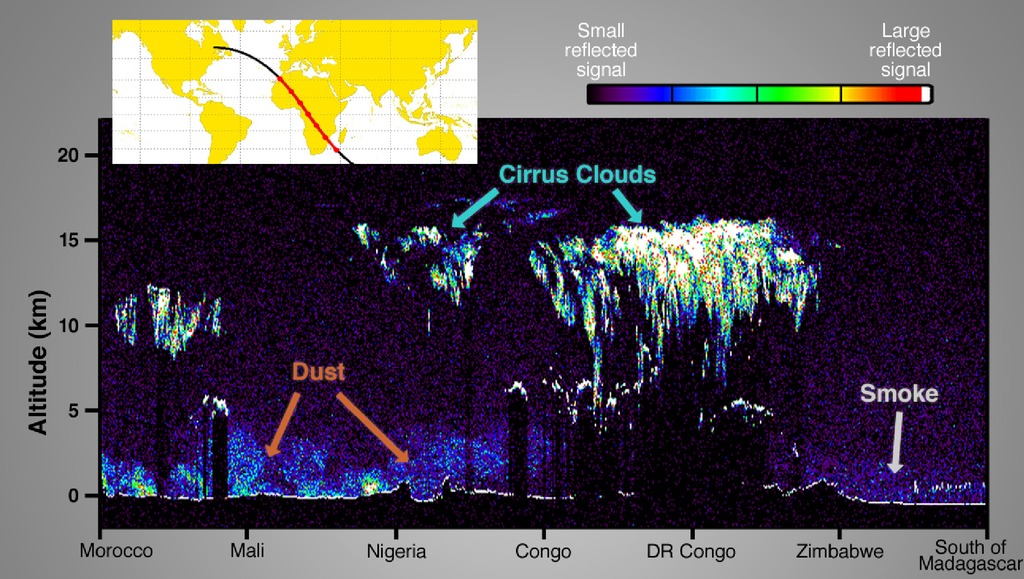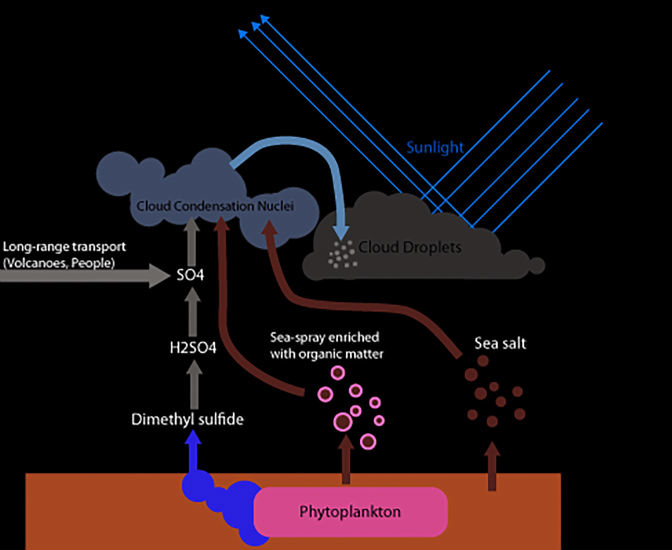When and where clouds form are important for climate science. Long-term observations have shown that at any given time less than 10 percent of the Earth’s skies are clear with no clouds. We most certainly want to know what is going on in the major 90 percent fraction covered with clouds of some type.
Some clouds reflect the sun’s radiation while others trap outgoing heat that would otherwise be emitted to space. Tiny solid and liquid particles suspended in the atmosphere are called aerosols. They act similar to clouds, some aerosols scatter light and cause a cooling effect while others absorb light and cause a heating effect. Most natural aerosols have large particle sizes with high hygroscopicity (ability to attract and condense water around them). Such natural aerosols can seed clouds of various types at different altitudes.
For more than a decade, scientists have used NASA’s Terra and Aqua satellites to create a long-term record of clouds and aerosols in Earth’s atmosphere. In the visualization below, red areas show aerosol plumes made up of smaller particles. These red-colored plumes are human caused pollution. Green areas show aerosol plumes made up of larger particles. Green-colored plumes are natural aerosols. Yellow areas correspond to plumes in which large and small aerosol particles are mixing. Gray shows where the satellite could not measure aerosols. The visualization shows monthly aerosol particle radius between January 2005 and 2013, using data from the Moderate Resolution Imaging Spectroradiometer (MODIS) sensor on NASA’s Terra satellite.
Aerosols are important to scientists because they can affect climate, weather, and people’s health. Using satellites scientists can tell whether a given plume of aerosols came from a natural source or were produced by human activities. Two important clues about aerosols’ sources are particle size and location of the plume. Natural aerosols (such as dust and sea salts) tend to be larger than man-made aerosols (such as smoke and industrial pollution).
Presence and absence of aerosols and cloud formation are interrelated. Low, dense sheets of stratocumulus clouds hanging just above the surface cool more than they heat efficiently shielding against incoming sunlight. In contrast, the feathery cirrus clouds, that can be hard to see from the ground. They form at altitudes higher than 6000 meters (20,000 feet). At those heights the temperature is below freezing. For this reason cirrus clouds are made of ice crystals. Cirrus clouds allow most incoming sunlight to pass through them, but they tend to trap heat emitted from the Earth’s surface having a warming influence. Trailings produced by jet aircraft are suspected to contribute to global warming more than others since they form at high altitudes.
The MODIS sensor has a unique band for measuring infrared light at a wavelength of 1.38 micrometers—a wavelength that NASA scientists realized is highly sensitive to cirrus clouds. The following animation (below) shows monthly average cirrus cloud fraction over the Earth between January 2005 and 2013 based on MODIS data. Bright white pixels indicate regions completely covered by cirrus clouds. Greyish-white pixels show partial cirrus cover and dark pixels indicate little or no cirrus:
At any given time, cirrus clouds cover nearly one-third of the Earth. Using instruments aboard high-altitude research aircraft and analyzing particles collected over a nine-year period (2002-2011) from flights in regions of North America and Central America MIT researchers found that the majority of cirrus cloud particles freeze around mineral dust and metallic aerosols. Metallic aerosols included lead, zinc and copper are all generated by industrial activities such as smelting and open-pit burning of electronics. Small plane engines also emit lead. Unlike other aerosol studies, there was very little evidence of biological particles, such as bacteria or fungi, or black carbon emitted from automobiles and smokestacks. Knowledge of which particles are absent in high altitude clouds is quite informative.
There appears to be a negative relationship between burning and weather patterns. For example in Africa, the combined effect of many small man-made fires in Northern Africa appears to be preventing clouds from forming according to Michael Tosca of NASA’s Jet Propulsion Lab. The following visualization shows the vertical distribution of clouds and plumes of dust and smoke measured by the CATS lidar instrument installed on the International Space Station as it passed over Africa on February 11, 2015.
Similar to smoke generated by subsistence farmers in Africa, pollution in China was observed to be preventing cloud formation. In 2015 suppressed clouds in the form of moist air mass moved northward toward the Longmen Mountains, which tower some 2000 meters above the basin and suddenly condensed at an unprecedented rate to trigger catastrophic floods in China.
Another way clouds can form is based on the organic volatile compounds emitted by trees. Trees are important not only for the carbon they capture and store but also for what they capture, convert and release into the air. Compounds emitted from forests are highly hygroscopic and serve as seeds to cloud formation. Terrestrial vegetation is estimated to release 90 million tons of such compounds per year to the atmosphere. These compounds oxidize and form larger even more hygroscopic aerosols that can further increase cloud condensation nuclei. They can therefore play an important role for the climate, especially in the vast forested regions such as the taiga or the tropical rainforests. Trees are important not only for the carbon they capture and store, but also for what they capture, convert and release into the air as aerosols.
Trees are important not only for the carbon they capture and store, but also for what they capture, convert and release into the air as aerosols.
Researchers already know a great deal about massive plumes of iron-rich desert dust coming from the Sahara desert. These plumes of dust can seed clouds and also fertilize the Amazon. However towards the inland away from the Atlantic, Amazonian rainforest air consist mostly of oxidized organic compounds derived from isoprene and terpenes. The primary role of these compounds are defense against insects and fungal pathogens. These organic aerosol particles can grow larger in size. It appears there is an unknown source among the living biota that emits Potassium-salt–rich particles. These salt particles help organic aerosols to get bigger. Altogether the sources of condensation seed for clouds becomes more diverse and local.
Similarly, cloud formation can also be initiated by sea spray, and organics emitted from phytoplankton. Marine organisms could be a significant source of atmospheric aerosols. In Southern Ocean biologically activive areas are generally cloudier. On average, the ocean life boosts the number of cloud droplets by about 60% annually. The effect is strongest during the summer of southern hemisphere. Phytoplankton activity increases formation of more bright reflective clouds. This is breathtakingly perfect since the incoming radiation is strongest during the summer. Phytoplankton can emit dimethyl sulfide gas which becomes sulfate in the air. Sulfate is a highly efficient cloud condensation nucleus. The sea spray contains organic matter on the skins of tiny bubbles in surface waves. Just like the isoprene and terpenes released from land plants, when the waters churn these loaded bubbles pop and release these organics into the air as cloud condensation nuclei.
At any time 90 percent of our planet’s skies are covered with clouds of one sort or another and it is important to know when, why and how.




1 Comment